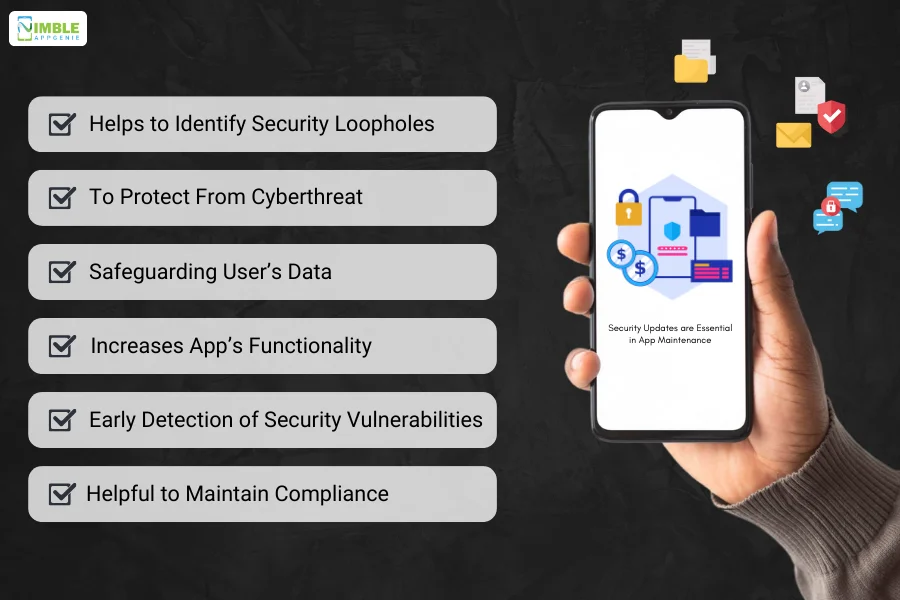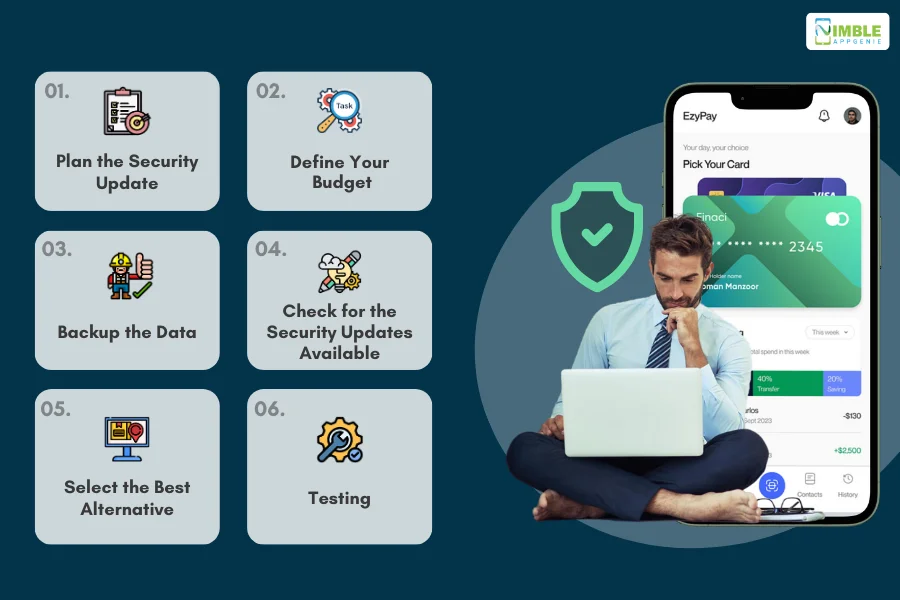Security updates are one of those underrated terms that can cause serious issues, even app failures.
Well, are you ready to take risks with the security updates during app maintenance?
A variety of tasks require to be updated while you maintain an app. This can impact the overall functionality of the app along with affecting users’ satisfaction scores.
When you maintain an app, security updates should be your priority to avoid any risk related to data breaches or any kind of cyberattacks.
Here is a complete solution that defines the role of security updates in app maintenance. We will discuss the importance, features, threats, time for an update, and future trends in security updates during app maintenance.
Let’s begin it together.
What are the Security Updates in App Maintenance?
Security updates in app maintenance are all about performing modifications or applying a patch to an operating system. This process is conducted to reduce security vulnerabilities and increase the complete functionality of an app.
During app maintenance, checking out the security of an app becomes a crucial process that can increase users’ trust and build long-term relations.
In the next section, you will learn more about the importance of adopting security updates during app maintenance.
Why are Security Updates Essential in App Maintenance?

Why update security features during app maintenance?
After learning about the concept, the next step is to consider its importance.
Check for security updates and app maintenance.
1. Helps Identify Security Loopholes
A security loophole is a vulnerability within the operating system that enables an attacker to compromise the entire application.
Security updates during app maintenance can be effective in identifying these loopholes before they leave a negative impact on the operating system.
2. To Protect From Cyberthreat
Cyberthreat is a growing risk in the current digital world. Hackers wait for one particular gap to identify the loophole and attack the app’s software to gain sensitive data.
Updating the app security can result in developing a wall that provides complete protection to users’ data. It helps to bridge the gap by implementing required security measures.
3. Safeguarding Users’ Data
Different kinds of apps handle sensitive user information, including login credentials, personal messages, and financial details.
Checking for security updates during app maintenance protects users’ privacy and creates long-term trust in the brand.
4. Increases App’s Functionality
An app with effective security measures results in increasing the app’s functionality and can improve user satisfaction.
Updated security features reduce and address underlying issues, including crashes, freezes, and other types of malfunctions. This ultimately enhances the overall app’s functionality.
5. Early Detection of Security Vulnerabilities
Do you want to identify security vulnerabilities earlier than when they create an issue for your app?
Well, performing security updates can be helpful here. The right app maintenance process is essential for detecting security vulnerabilities and addressing them on time.
6. Helpful in Maintaining Compliance
Implementation of security updates during app maintenance is essential for maintaining data privacy and mandates upholding specific security standards.
Regular security updates display a commitment to compliance by avoiding any legal trouble during app maintenance.
These are some of the reasons why security updates are important during app maintenance. Find out how to update the security feature in the next section.
How to Update Security Features During App Maintenance?
Do you want to implement best practices of app maintenance for your software?
Well, security updates are among them. After learning the importance, let’s learn about the process of updating security features during app maintenance.

Step 1: Plan the Security Update
The foremost step in updating the security feature during maintenance is planning. You cannot think of executing the security update process without the right planning steps.
Before planning, market research can be effective for introducing current security measures that are in trend and essential to implement as per updated market technologies.
Step 2: Define Your Budget
There are a variety of security updates you can implement based on your budget. Thus, you need to decide on the right budget for the app’s security updates.
Here, the cost invested in mobile app maintenance plays a crucial role. The security update budget depends on this cost and can vary depending on the app’s complexity, its core functionality, etc.
Step 3: Backup the Data
Before you execute security updates for app maintenance, you should keep a data backup. This process is essential for protecting the data from getting lost.
It is useful and effective for protecting sensitive information as well as providing disaster recovery. Providing data backup can ensure a competitive advantage for the business and build users’ trust.
Step 4: Check for Security Updates Available
After analyzing the data from the market research, you should create alternatives based on different budget plans.
Here, you should analyze different kinds of security updates available in the market recently. Later, you can select the right type of update based on the app’s needs.
Step 5: Select the Best Alternative
Now, you should select the appropriate alternative based on the current practices and available robust technologies in the market.
After selecting, you should implement it during the app maintenance process. Here you should note that the selected alternative needs to comply with the current trends and the need for security updates.
Step 6: Testing
The last step is to test the selected security measure under different circumstances. Testing will help in identifying the related errors and bugs that can cause issues further.
Mobile app testing is an important protocol for checking out the security implications. You should perform testing of robust technology implementation and keep the least or bug-free alternative.
Certain steps should be undertaken to adopt security during app maintenance.
Bonus Read: Mobile App Security
What are the Threats to the App Due to a Lack of Security?
Till now, we have discussed the importance of security updates, their concept, and their process while app maintenance.
Now, let’s get one more step ahead by learning about the threats due to a lack of security updates during app maintenance.

1] Data Breaches
Data breaches are a consequence of a lack of security that can occur when sensitive information is transferred without any kind of authorization.
If you avoid security checks during app maintenance, it can result in insufficient encryption of stored data, which will further invite cybercriminals to take advantage of such a scenario.
2] Malware Attacks
Malware can be stated as a code that harms a mobile app which usually accesses private information and can be spread through links, downloads, and apps.
Cybercriminals are constantly searching for ways to exploit apps that are being used widely. Often, a lack of robust security provides an opportunity for such malware attacks to respond.
3] Denial-of-Service (DoS) Cyber Attack
In this type of attack, the target of hackers is to launch a DoS. This attack leads to frustrated potential users from accessing the app.
This can result in reputation damage and may develop a perception of unreliability, which can result in financial loss or lost revenue during the app’s downtime.
4] Weak Encryption
One of the high threats due to lack of security is weak encryption which results in increasing malicious activities. This can further result in unauthorized modification of data that can enhance fraud.
Even if the data cannot be fully decrypted by the hacker, they can still manipulate it, resulting in misrepresentation.
5] Poor API Protection
Did you forget to protect or update your API? Well, then it could be among your last app maintenance mistakes to avoid in the current era.
Within the app maintenance and security updates, you should be able to secure the API connection for prioritizing the third-party integration. Avoiding it can impose significant security risks.
6] Compliance Issues
If you fail to maintain effective security standards can result in violations of data regulations such as GDPR or CCPA, which can lead to hefty fines.
Avoiding legal policies and regulations can result in serious consequences, which may lead to lawsuits or legal actions.
These are some of the common threats that can take place when you avoid security practices.
When are Security Updates Required?
Do you think security updates are required regularly?
Well, some of them may be. Let’s learn about them in detail.
It’s important to perform updates in the app; here’s when you need to perform security updates.
| Timing | Reason | Frequency |
| Immediate Updates | New critical vulnerabilities discovered | As needed |
| Scheduled Maintenance | Routine update cycle | Monthly |
| Post-Incident | After a security breach or incident | As needed |
| Compliance Deadlines | Regulatory requirements or standards change | As needed |
| Dependency EOL | End-of-life for software libraries/frameworks | As needed |
| Performance Issues | Security features impacting performance | As needed |
| Penetration Testing Results | Findings from penetration tests | Quarterly |
| User Reports | Reported security issues from users | Weekly |
| Threat Landscape Changes | Emerging or evolving threats | As needed |
| Third-Party Service Changes | Updates to third-party services/APIs | As needed |
This will help you to identify and implement routine app maintenance based on required case scenarios.
Now, let’s opt for future trends that can help you to become competitive in these changing security updates.
Future Trends to Update Security During App Maintenance
Going with the changing market trends is crucial and should be an important practice to undertake while app maintenance.
Certain future trends that you can adopt are as below.
![Future_Trends_to_Update_Security_While_App_Maintenance[1]](https://www.nimbleappgenie.com/blogs/wp-content/uploads/2024/07/Future_Trends_to_Update_Security_While_App_Maintenance1.webp)
♦ An Increased Focus on AI and Machine Learning
AI and machine learning tend to play a critical role in cybersecurity practices. Advanced AI data analysis capabilities are utilized for identifying and predicting future cyber threats. With early detection systems, AI and machine learning play an optimal role.
♦ Implementation of IoT Security
The Internet of Things continues its exponential growth, which allows the connection of a large number of devices.
However, there are a variety of security challenges within the interconnected nature of devices through IoT. The growing use of multiple devices decreases the practice of using IoT for security data.
♦ Adopting Automation in Cybersecurity
Automation within cybersecurity practices is one of the most important points to be considered in the changing technologies. The integration of security measures into agile development processes is essential for implementing automation during app maintenance.
♦ Zero Trust Security Model
The Zero Trust model is one of the strategic approaches for cybersecurity that provides security to the brand by avoiding trust and regularly validating each stage of digital connection. Under this model, a strict principle follows comprised of “never trust, always verify”.
♦ Implementation of Blockchain and Cybersecurity
In the current era, blockchain technology is continuously being recognized. It is a ledger technology that is known for its inherent security measures that secure and protect sensitive data from cyber threats. This is an important feature useful for protecting data, including personal and financial transactions.
♦ Adopting Cybersecurity Insurance
Cybersecurity insurance is a new trend and an important mainstream component of business risk management. Many businesses have adopted cybersecurity insurance to successfully integrate processes associated with data breaches and cyberattacks.
♦ SecureDevOps
Integration of new security practices into every stage of the development lifecycle plays an important role. Here you can implement continuous monitoring as well as testing systems for security vulnerabilities. This is a safe and secure practice that can enhance the overall app’s operations.
Connect With Nimble AppGenie to Update Security Features During App Maintenance
Having a team that can help you implement the updated security practices is precious, right?
Well, if you are in search of a team that is experienced and can help in implementing effective security measures, then you can switch to Nimble AppGenie.
We are an experienced Mobile App Maintenance Service Provider with the right panel of experts who take care of every single requirement of our clients.
Along with security updates, you can trust us with sustainable or routine app maintenance tasks that can increase your market presence.
Conclusion
Security updates play a pivotal role in app maintenance. It helps to identify security loopholes within the app, ensures protection from cyber threats, safeguards users’ data, and is helpful in compliance updates.
Along with this, the right security app maintenance comprises planning the security update, defining the budget, backing up the data, checking for security updates, and testing.
There are several security threats that you should be bothered of, including weak encryption, poor API, malware attacks, denial of service attacks, and compliance issues.
You can adopt future trends such as the adoption of AI and machine learning, the implementation of IoT security, the zero trust security model, and the adoption of cybersecurity insurance.
These trends can help you to run according to the current time practice. Additionally, connecting with an experienced enterprise can help here to implement security updates for app maintenance.
FAQs
Here are certain steps to include for updating the security feature which can be stated below.
- Planning a security update.
- Define your budget.
- Backing up data.
- Check for available security updates.
- Selecting the best alternative.
- Testing the selected security measure.
Security updates should be performed:
- Immediately when new critical vulnerabilities are discovered.
- Monthly, during scheduled maintenance.
- As needed after a security breach or incident.
- As needed to meet compliance deadlines.
- As needed when dependencies reach end-of-life.
- As needed to address performance issues.
- Quarterly based on penetration testing results.
- Weekly in response to user reports.
- As needed due to changes in the threat landscape.
- As needed for third-party service changes.
Certain Future trends include comprises of security updates for app maintenance:
- Increased use of AI and machine learning for threat detection.
- Implementation of IoT security measures.
- Adoption of automation in cybersecurity.
- The zero trust security model.
- Utilization of blockchain technology for data protection.
- Adoption of cybersecurity insurance.
- Secure DevOps practices with continuous monitoring and testing.

Niketan Sharma, CTO, Nimble AppGenie, is a tech enthusiast with more than a decade of experience in delivering high-value solutions that allow a brand to penetrate the market easily. With a strong hold on mobile app development, he is actively working to help businesses identify the potential of digital transformation by sharing insightful statistics, guides & blogs.
Table of Contents




![CTA-1_--Do_you_want_to_implement_security_updates_during_app_maintenance__(1)[1]](https://www.nimbleappgenie.com/blogs/wp-content/uploads/2024/07/CTA-1_-Do_you_want_to_implement_security_updates_during_app_maintenance__11.webp)
No Comments
Comments are closed.